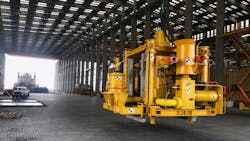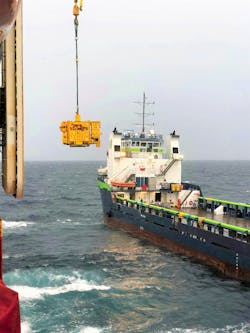Standardization enables flexible, cost-effective subsea tree delivery
The oil and gas industry needs reliable products that can be adapted and customized swiftly and installed without costly delays. Particularly in today’s challenging market, offshore companies are looking for solutions that deliver time- and cost-savings without compromising functionality and safety. The introduction of a modular subsea production tree, recently installed in the Gulf of Mexico (GoM), shows how a standardized horizontal tree design can cut time to production without compromising safety.
The lay of the land
No one is surprised by ups and downs in oil and gas pricing, but current conditions have introduced unprecedented uncertainty. Understanding what customers need is essential to changing the status quo, said Danny McLaughlin, Dril-Quip product manager for subsea production systems and trees. “Companies want quick delivery and reliable products,” he said, “but they also need customization. Product designs need to be flexible so that they can be easily engineered, designed, and manufactured to meet the requirements of our customers.” They also need to be reliable for long-term deployment, he said. “We know how important reliability is,” McLaughlin added. “That’s why we built an in-house test facility that allows us to test our designs over and above the conditions they will see in the field. We test our products more than anyone else in the industry.”
The company has been designing trees since its inception in 1981 and has installed more than 350 units globally. “Many of these were designed for a work life of 25 years and have been in operation for 15 to 20 years without incident,” McLaughlin said. “Even after years of use, they continue to function as designed.”
In developing its horizontal subsea tree (HXT), the company built on the foundation of solid product designs and incorporated feedback from customers who said they needed customization, but also wanted quick delivery. “The result is a horizontal tree that uses components the company keeps in stock and that we designed for easy customization,” he explained. “That means we can start with a basic unit and quickly configure for customer requirements.”
The basic tree has a fully populated tubing hanger system with nine hydraulic and two electrical downhole lines for maximum flexibility. It also is outfitted with the proprietary Dril-Quip DXe wellhead connector, developed specifically for HP/HT service and severe bending and high-fatigue environments. The connector, which was recognized by SPE at the 2017 Offshore Technology Conference with a Spotlight on New Technology Award, is compatible with existing BOP hydraulic control systems. “This is an exceptionally durable component,” McLaughlin said. “We bend tested it to 20 million pounds in our facility and put it through 90 million cycles of fatigue testing without failure.”
By combining resilient components in a standard tree that is amenable to customization, Dril-Quip can deliver a robust subsea tree in a short period of time. The company demonstrated its quick turnaround with the GoM project. “It took only 15 months from the placement of the order to the installation, despite the pandemic and weather events,” McLaughlin said.
Installing serial number one
Nick Henderson, senior business development manager for Dril-Quip, worked closely with the customer during the entire project. He said the compressed delivery schedule was one of the big pluses for the operator. The order was placed in June 2019, and the HXT was delivered in early August 2020, with installation completed by the end of September. “Of course, getting an operator onboard with installing ‘serial number one’ of our horizontal tree was based on more than the timeline,” Henderson said. “We had supplied subsea trees in the past and had built a relationship, so the operator trusted our ability to provide reliable technology.”
Because of the travel restrictions imposed by the pandemic, being based in Houston was another selling point. “It was easy for the operator’s team members to visit our facility and witness the tests we carried out on the tree,” he said, noting that the level of testing offered additional assurance that the tree would perform as anticipated when it was installed.
“We have testing equipment on site to test the product at any stage of development, so we can even do systems integration testing in house,” Henderson said. “Another plus is that our manufacturing – which is ISO- and API-certified – is done at the same location.” With the engineering team working alongside manufacturing, troubleshooting is quick, and modifications can be made and tested expediently, he said.
Mobilizing the tree
Once the tree had undergone complete testing in Houston, it was moved to Port Fourchon, Louisiana, to be prepared for transport and installation offshore. Additional dockside testing was done at C-Port before the unit was transferred to a vessel of opportunity for installation. According to Henderson, the compact size of the tree and its weight (the complete package weighs less than 50 tons) enables installation from a broad range of vessels, which helps to reduce the cost and time required for installation.
Mother Nature threw a curveball with three hurricanes traversing the GoM while the HXT was being installed. “None hit the wellsite, but the rig had to be unlatched from the BOP and moved offsite and then returned to the site when conditions improved. The number of times we had to go back into the tree was greater than normal, but even so, the installation went flawlessly,” Henderson said.
Adapting to changing times
According to McLaughlin, the current depressed market is a wakeup call for the industry that demands a reassessment of how offshore fields are being developed. “These conditions necessitate a fundamental shift to keep the offshore alive,” he said. “We need to change how we design and deliver products and rethink how offshore drilling and completions are done if we are going to achieve real savings.”
There also needs to be cognizance of the impact on the environment, McLaughlin said. “We need to eliminate hardware where we can, cut back manufacturing time, and reduce greenhouse gas emissions by shortening the time spent on installations. Flexibility is vital to making this transition. In the end, a smaller carbon footprint is positive for everyone and greater efficiencies benefit us all.”




